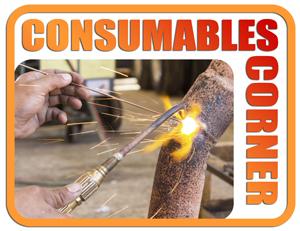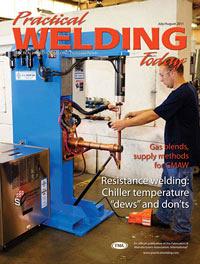Senior Sales Application Engineer
- FMA
- The Fabricator
- FABTECH
- Canadian Metalworking
Categories
- Additive Manufacturing
- Aluminum Welding
- Arc Welding
- Assembly and Joining
- Automation and Robotics
- Bending and Forming
- Consumables
- Cutting and Weld Prep
- Electric Vehicles
- En Español
- Finishing
- Hydroforming
- Laser Cutting
- Laser Welding
- Machining
- Manufacturing Software
- Materials Handling
- Metals/Materials
- Oxyfuel Cutting
- Plasma Cutting
- Power Tools
- Punching and Other Holemaking
- Roll Forming
- Safety
- Sawing
- Shearing
- Shop Management
- Testing and Measuring
- Tube and Pipe Fabrication
- Tube and Pipe Production
- Waterjet Cutting
Industry Directory
Webcasts
Podcasts
FAB 40
Advertise
Subscribe
Account Login
Search
Consumables Corner: Welding weathering-grade material with a nickel-containing filler
- By Jay Ginder and Jerry Mathison
- June 27, 2014
- Article
- Consumables
Q: I work for a structural steel fabricator and we are getting ready to start work on a bridge job that specifies A588 material. We have worked on this material in the past using a weathering-grade filler metal. Our engineer has recommended we use a 1 percent nickel electrode. Is this right?
A: Good question! The A588 steel is a weathering-grade material. This high-strength, low-alloy (HSLA) material produces a protective oxide layer that actually improves its corrosion resistance. For example, some bridges look as if they were never painted and appear be rusty. It is a good bet they are made from weathering-grade steel. These steels usually are alloyed with small amounts of copper and could have a slightly higher level of phosphorus as well.
Historically, these steels were developed first, followed by welding electrodes containing small amounts of copper. The main reasons for creating a matching electrode is to match the strength level and allow the weld metal to form the same oxide layer as the base material for a consistent rusty appearance.
In recent years many fabricators have moved away from using filler metals that contain copper (normally weathering-grade materials use 0.30 to 0.75 percent Cu) because of the increased risk of hot cracking problems. Hot cracking can result from lower-melting-temperature elements like phosphorus. The industry has moved toward a safer alternative with filler metals that contain 1 percent nickel. This filler metal normally is used when the material and weld must meet low-temperature impact toughness (ductility), but it also provides some corrosion resistance qualities as well. If proper welding procedures are used, the 1 percent nickel filler generally will present no problems. In some cases, you’ll need to take the joint type, configuration, and weld size into consideration to ensure the weld will form the oxide layer similar to the base metal. This is accomplished by diluting the base material into the weld deposit.
In your case, your engineer will have to consult with your customer to find out if the filler metal it specified is something other than the 1 percent nickel. If the specification calls for a weathering-grade filler material, it is also available and can be used successfully. If your customer specifies a 1 percent nickel, you will need to qualify the filler material and joints you will be using.
About the Authors
Jay Ginder
Filler Metal Manufacturing Center 801 Wilson Ave.
Hanover, PA 17331
Jerry Mathison
Senior Sales Application Engineer
411 S. Ebenezer Road
Florence, SC 29501
843-669-4411
About the Publication
Related Companies
subscribe now

The Welder, formerly known as Practical Welding Today, is a showcase of the real people who make the products we use and work with every day. This magazine has served the welding community in North America well for more than 20 years.
start your free subscription- Stay connected from anywhere

Easily access valuable industry resources now with full access to the digital edition of The Fabricator.

Easily access valuable industry resources now with full access to the digital edition of The Welder.

Easily access valuable industry resources now with full access to the digital edition of The Tube and Pipe Journal.
- Podcasting
- Podcast:
- The Fabricator Podcast
- Published:
- 04/16/2024
- Running Time:
- 63:29
In this episode of The Fabricator Podcast, Caleb Chamberlain, co-founder and CEO of OSH Cut, discusses his company’s...
- Industry Events
16th Annual Safety Conference
- April 30 - May 1, 2024
- Elgin,
Pipe and Tube Conference
- May 21 - 22, 2024
- Omaha, NE
World-Class Roll Forming Workshop
- June 5 - 6, 2024
- Louisville, KY
Advanced Laser Application Workshop
- June 25 - 27, 2024
- Novi, MI
































